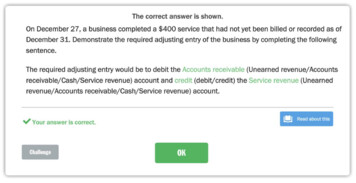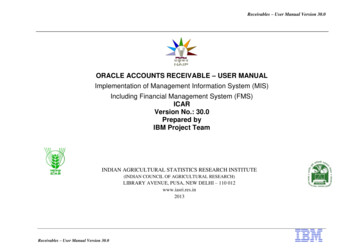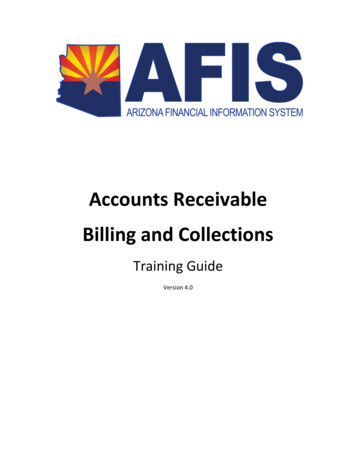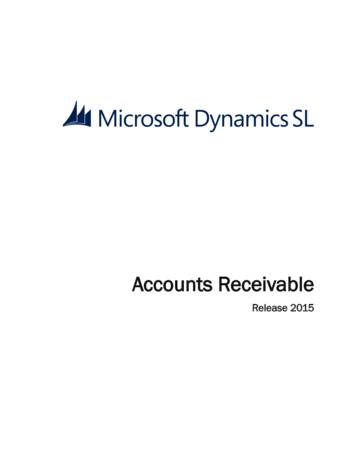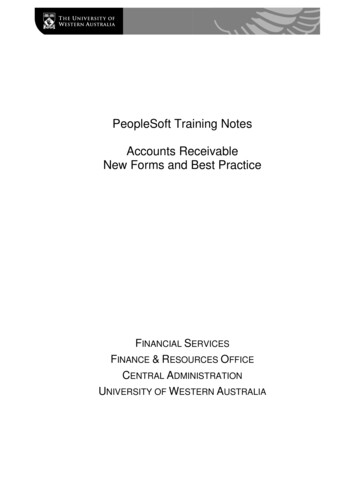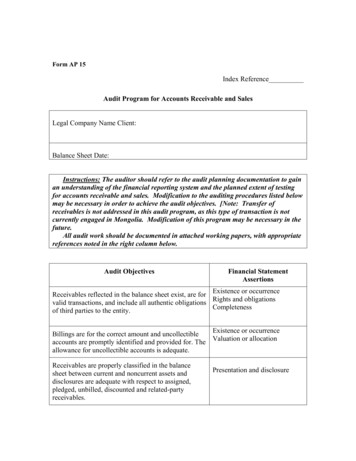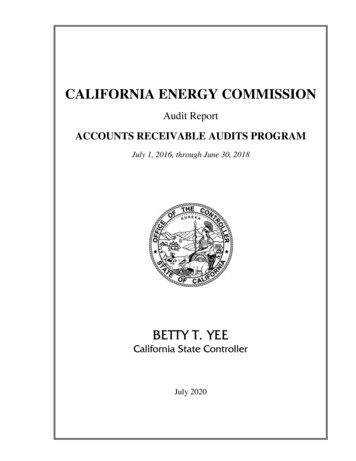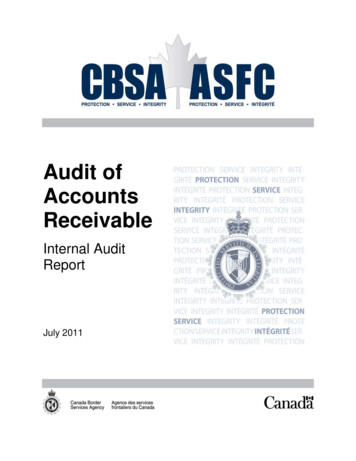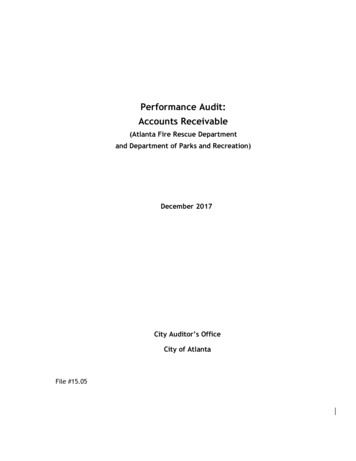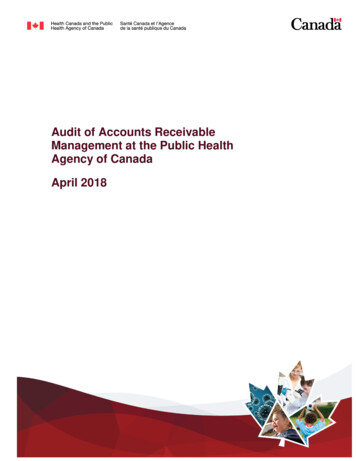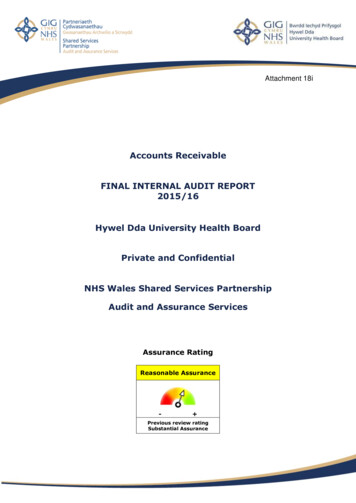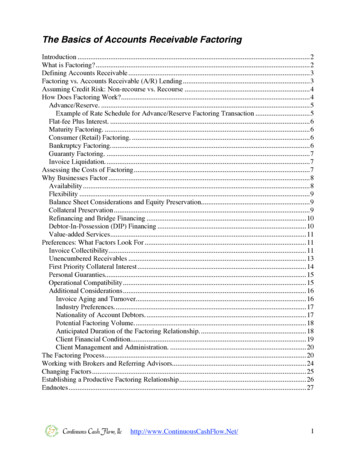
Transcription
The Basics of Accounts Receivable FactoringIntroduction .2What is Factoring? .2Defining Accounts Receivable .3Factoring vs. Accounts Receivable (A/R) Lending.3Assuming Credit Risk: Non-recourse vs. Recourse .4How Does Factoring Work?.4Advance/Reserve. .5Example of Rate Schedule for Advance/Reserve Factoring Transaction .5Flat-fee Plus Interest. .6Maturity Factoring. .6Consumer (Retail) Factoring. .6Bankruptcy Factoring.6Guaranty Factoring. .7Invoice Liquidation. .7Assessing the Costs of Factoring.7Why Businesses Factor .8Availability .8Flexibility .9Balance Sheet Considerations and Equity Preservation.9Collateral Preservation .9Refinancing and Bridge Financing .10Debtor-In-Possession (DIP) Financing .10Value-added Services.11Preferences: What Factors Look For .11Invoice Collectibility.11Unencumbered Receivables .13First Priority Collateral Interest .14Personal Guaranties.15Operational Compatibility.15Additional Considerations.16Invoice Aging and Turnover.16Industry Preferences.17Nationality of Account Debtors. .17Potential Factoring Volume.18Anticipated Duration of the Factoring Relationship. .18Client Financial Condition.19Client Management and Administration. .20The Factoring Process.20Working with Brokers and Referring Advisors.24Changing Factors .25Establishing a Productive Factoring Relationship.26Endnotes .27Continuous Cash Flow, llchttp://www.ContinuousCashFlow.Net/1
The Basics of Accounts Receivable FactoringIntroductionOver the past fifteen years, growing numbers of small and mid-sized companieshave begun to explore factoring as a practical source of working capital. Unfortunately,the availability of accurate, up-to-date information has not kept pace with themounting interest in this much under-utilized form of commercial financing. Wetherefore present the following discussion for those seeking a broader understanding ofthis dynamic alternative to traditional debt/equity funding.What is Factoring?The term "factoring" refers to the outright purchase and sale of accountsreceivable (A/R) invoices at a discount from their face value. The structure, terms andconditions of such a transaction may vary in any number of ways, as evidenced by thearray of factoring programs currently available throughout the United States.Companies engaged in the business of buying accounts receivable are called"factors." Factors often exhibit a flexibility and entrepreneurial awareness rarelydemonstrated by banks and other secured lenders, whose activities are more generallyrestricted by regulation and prevailing law.Companies selling their receivables are typically referred to as "clients" or"sellers" (not "borrowers"). The client's customers, who actually owe the moneyrepresented by the invoices, are generally known as "account debtors" or "customers."Characteristically, there seems to be no industry-wide term of art to describethe actual event that occurs when a factor accepts invoices for purchase. Commonterms for this event include: "schedule," "funding," "advance," "assignment" and"transaction."1The cash which a factor issues to a client as initial payment for factored invoicesis typically called an "advance."Factoring differs from commercial lending because it involves a transfer ofassets rather than a loan of money. In assessing risk, therefore, factors look primarilyto the quality of the asset being purchased (i.e. the ability to collect clientreceivables), rather than to the underlying financial condition of the seller/client. Thisfocus makes factoring a suitable vehicle for many growing businesses when traditionalcommercial borrowing proves either impractical or unavailable.Continuous Cash Flow, llchttp://www.ContinuousCashFlow.Net/2
Defining Accounts ReceivableIn the factoring industry, the term "accounts receivable" normally refers toshort-term commercial trade debt having a maturity of less than 90 or, at the outside,120 days. To be sure, factors sometimes receive offers to purchase longer-term debtobligations, such as leases or commercial notes. The purchase of such debtinstruments, however, does not fall within the meaning of the term "factoring" as it ismost commonly used.Factors are universally quick to distinguish between invoices (which representlegally enforceable debts) and purchase orders (which do not). Most factors refuse toadvance money against purchase orders under any circumstances. A few, however,have developed separate purchase order financing programs.Similarly, factors generally refuse to purchase "pre-ship" invoices that clientssometimes generate prior to shipping goods or providing services to account debtors.Many factors will immediately terminate a factoring relationship if they discover thattheir clients are attempting to factor "pre-ship" invoices.Factoring vs. Accounts Receivable (A/R) LendingAlthough factoring is occasionally confused with A/R lending, it differs bothlegally and operationally.Legally, a factor takes immediate title to the invoices it purchases. The A/Rlender, on the other hand, never takes title to invoices unless and until the borrowerdefaults on its loan agreement.In connection with the transfer of title, the factor purchases the right to collectpayments directly from account debtors, who thus become legally obligated to thefactor. An A/R loan, however, does not legally obligate account debtors to pay thelender directly, except when the lender notifies them of a default by the borrower.Operationally, the factor differs from the A/R lender because the factorconcentrates on the aging, collection, and posting of each factored invoice. Bycontrast, the A/R lender does not track the payment status of every individual invoicegenerated by the borrower in the normal course of business.Further, while an A/R lender will have virtually no interaction with individualaccount debtors, the typical factor will find it necessary to contact them directly as amatter of course.A/R lenders do not normally take an active role in collecting invoice payments,although they may sometimes set up a "lockbox account," to which a given borrower’sentire invoice proceeds must be initially directed and deposited. Under thisContinuous Cash Flow, llchttp://www.ContinuousCashFlow.Net/3
arrangement, the lender (or designated trustee) then "sweeps" the lockbox on aregular basis, deducts for the benefit of the lender any outstanding loan payments,fees or other charges due from the borrower, and deposits the remaining balance in theborrower's operational account. This system enables the lender to monitor generalcash flow, ensure immediately available funds covering the borrower's obligations tothe lender, and preserve access to the collateral if the borrower defaults.A factor, however, must directly collect the proceeds of specifically purchasedinvoices in order to recover its advances and fees. General administration of a lockboxrequires relatively little operational effort compared to the myriad processing,collection and reporting activities which factors routinely perform (see "The FactoringProcess," below). The fact is, unless they also provide factoring services, most securedlenders lack the necessary operating capability to collect and manage an invoiceportfolio of even moderate size.Since many financial service companies offer more than one type of financing itis not unusual to find factors also engaging in A/R lending. In general, A/R lendingprograms tend to be somewhat less expensive than factoring (although not always).A/R loans can be more difficult to obtain, however, since lenders normally expectgreater financial strength from borrowers than factors do from clients.Sometimes the distinction between factoring and A/R lending becomes lessclear. For example, recourse factoring, which is discussed below, has certain featuresthat make it legally comparable to A/R lending in some states, even though it isoperationally dissimilar.Assuming Credit Risk: Non-recourse vs. Recourse2What happens when an account debtor becomes financially unable to makepayment for an outstanding invoice that a factor has purchased? The answer dependson whether the factor operates on a non-recourse or recourse basis.In a non-recourse transaction, the factor purchases the underlying credit riskassociated with each factored invoice. The client therefore incurs no liability to thefactor if the account debtor proves financially unable to make payment. In such anevent, the factor must either absorb the loss or take direct enforcement action againstthe account debtor.A recourse transaction, however, allows the factor to make claims against theclient in order to recover losses caused by account debtor insolvencies. Recoursefactoring agreements generally require the client to repurchase any invoices thatremain unpaid after a certain number of days (typically 60 or 90).How Does Factoring Work?Factoring occurs in a variety of forms, which are briefly described below.Continuous Cash Flow, llchttp://www.ContinuousCashFlow.Net/4
Advance/Reserve.This type of factoring is by far the most widely practiced. Upon taking title toinvoices, the factor immediately pays to the client a percentage of their total facevalue. This payment (called the "advance") typically falls between 70% and 85%, butmay go as low as 50% or less (for example, in the case of construction or third-partymedical invoices), or as high as 90%. After successful collection of payment from theaccount debtors, the factor subsequently remits the balance of the invoice amount(s)(usually called "the reserve") to the client, minus the factor's earned fees.The reserve provides the factor with available funds from which to draw its fees,and furnishes a buffer against defaults by clients and/or account debtors.Some factors do not hold back a reserve balance, but rather advance the entireinvoice face value, less maximum factoring fees, at the time of purchase. This practiceis not widespread, howeve
Factoring vs. Accounts Receivable (A/R) Lending Although factoring is occasionally confused with A/R lending, it differs both legally and operationally. Legally, a factor takes immediate title to the invoices it purchases. The A/R lender, on the other hand, never takes title to invoices unless and until the borrower defaults on its loan agreement. In connection with the transfer of title, the .
